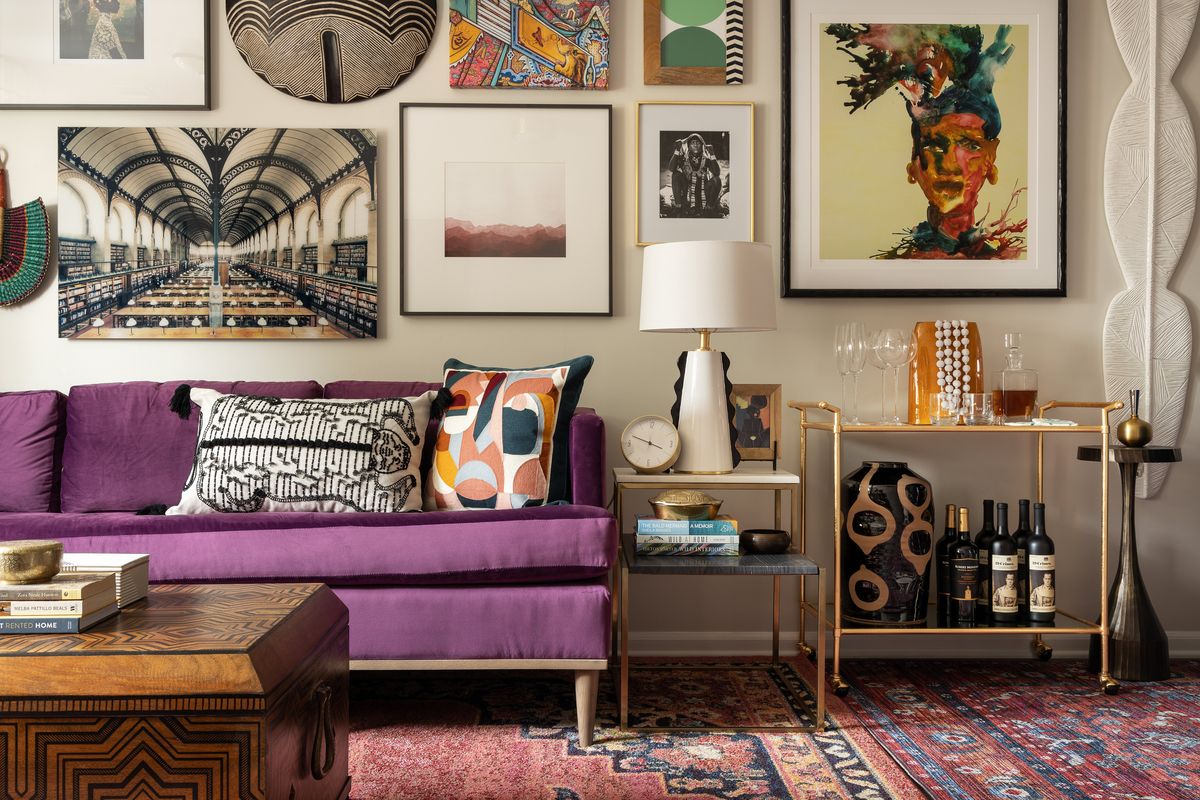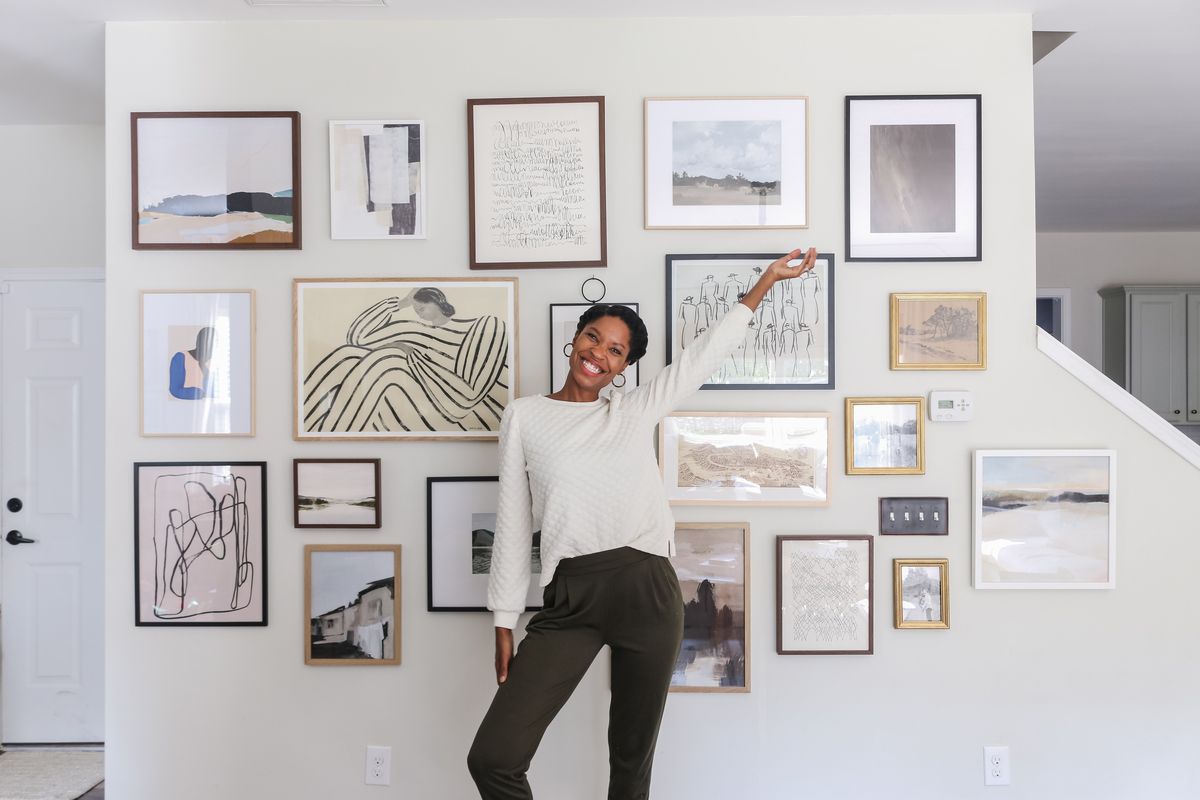How to build a gallery wall on a budget
A gallery wall designed by Beth Diana Smith. One way to build a gallery wall on a budget is to start with a small grouping and radiate out as more art is acquired. (Courtesy of Mike Van Tassel)
Gallery walls are a lot like Eames chairs and that one mirror from Anthropologie – they’ve been trendy for so long that it’s safe to say they’re not really a trend at all. And they’ve stuck around despite a couple significant hurdles. For one thing, the geometry involved in assembling one can induce the cold sweat of a pop calculus quiz. For another, buying and framing a whole gallery’s worth of artwork can get ridiculously expensive.
A little open-mindedness, however, can solve at least that second challenge. After all, “artwork” truly is in the eye of the beholder. “Follow your instincts of what you like and what brings you joy, and go from there,” says Sarah K. Benning, an embroidery artist in Baltimore who thrifts pieces for her gallery walls. “It doesn’t have to make sense to anyone else.”
Herewith, advice from gallery wall enthusiasts about how to build one on a budget.
Build your gallery gradually
There’s no rule that says you have to collect every single piece before you start installing your gallery wall. In fact, building it over time is a great strategy for spreading out the cost. In her old house, Benning spent four years putting together a gallery of vintage, antique and contemporary portraiture that hung in her stairwell. These days, she says she sets aside about $25 a month for her art collection.
To create your own gallery this way, experts recommend starting in the middle of the wall, either with a tight cluster of a few pieces or one large anchor piece, and building out from there. By radiating outward from a central focus, your collection will look purposeful and complete even though it’s a work in progress. If you decide to shift or switch things as it grows, the worst consequence will be a few holes in the wall – nothing that can’t be patched with spackling compound or wall filler.
Use items with sentimental value
Add personal touches that make your gallery wall uniquely yours. Collect art from street vendors or other inexpensive souvenirs on your travels. If your grandmother’s china is too outdated for everyday use, install a plate hanger and display it on the wall. Frame a meaningful note, or even the envelope it came in.
“My gallery walls are inspired by my culture and my experiences,” says Ayesha Anwar, who works in health equity in the Philadelphia area. Anwar is Pakistani and features Pakistani artists on her wall, along with Arabic calligraphy to represent her Muslim faith.
The items in a gallery don’t “have to be precious or what we might think of as having monetary value,” Benning says. As long as they’re sentimental, “there’s no right or wrong way to do it.”
Shop at home
You might already be living in a treasure trove of hidden items perfect for your gallery wall. “You just have to look at your own home with a different eye,” says Laura Hildebrandt, an interior designer and owner of Interiors by LH in Northern Virginia.
Tiffany DeLangie, a digital content creator in Raleigh, N.C., once framed a Hallmark gift bag with a pretty design. “Just be creative. If you love something, and it’s flat enough to go on the wall, then it can.”
Other items to consider: game boards, postcards, mirrors, clocks and hats. “Look out for shapes like circles – anything that has an organic edge to it would look good contrasted with squares and rectangles,” says Katie Falbo, a content creator and vintage furniture seller in Los Angeles.
Be thrifty with frames
Frames can quickly add to the cost of your gallery wall, so keep an open mind when sourcing yours. Browse for bargains at thrift stores and on Facebook Marketplace, or scour your own collection. If a frame isn’t quite right, you can usually repaint or redecorate it easily.
Anwar often upcycles frames she already has by painting them, adding metallic finish with gold rub, or stamping on a design. She also builds her own frames – especially for bigger items – by assembling molding or trim from a hardware store with wood glue and clamps. The project, she says, usually costs between $20 and $30.
Going very simple with thin, metal gallery frames is also perfectly acceptable, says Beth Diana Smith, CEO of Beth Diana Smith Interior Design in New Jersey. And sometimes, not using a frame at all looks cooler. Decorative push pins or double-sided tape can hold up Polaroids or ripped-out magazine pages.
Add texture
Artwork isn’t only made of paper or cardstock. “Mixing in textures really gives interest and allows it to be about you instead of something that looks cookie-cutter,” Hildebrandt says. “It really is only limited to your imagination.”
Try adding woven baskets to your gallery, or using a quilt hanger to display a small rug or tapestry. While browsing junk shops, Benning collected wood utensils and old textiles – including needlework, napkins and handkerchiefs – and put them on her wall. As a bonus, these types of items don’t require frames, a big savings.
Hildebrandt and Falbo recommend tacking up scarves or vintage T-shirts, or hanging a cool tile to add depth. You can also add a floating shelf to incorporate smaller objects, like figurines, candles or potted plants. Some don’t even require hardware.
Big gaps don’t mean
big spending
Don’t panic if there’s a big space to fill – there are plenty of inexpensive solutions.
Frame a piece of wallpaper (Hildebrandt suggests shopping eBay for leftovers) or gift wrap. Or use a textile, like a tapestry, that doesn’t require framing. Check out museum gift shops for poster-sized reprints of artwork. Natalie Papier, owner of Charlotte interior design company Home Ec., recommends framing maps of places that are meaningful to you.
If you’re artistic like Anwar – and allowed to (sorry, renters!) – you can stencil a design directly onto the wall. This fills up the blank space and allows you to hang smaller items over a patterned background. Anwar also creates her own prints on Canva, using the site’s design tools to overlap patterns, illustrations and images. She says Staples, Walmart and FedEx have affordable printing options.
And remember: Some gaps are fine. You don’t need to cover every inch of your wall for a gallery to look complete. “It’s OK to have empty space,” Hildebrandt says. “It gives room for growth.”

